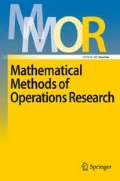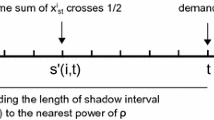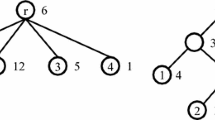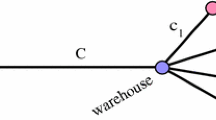Abstract
In this paper, we consider k-echelon extensions of the deterministic one warehouse multi-retailer problem. We give constant factor approximation algorithms for some of these extensions when k is fixed. We focus first on the case without backorders and we give a \((2k-1)\)-approximation algorithm under general assumptions on the evolution of the holding costs as products move toward the final customers. We then improve this result to a k-approximation when the holding costs are monotonically non-increasing or non-decreasing (which is a natural situation in practice). Finally we address problems with backorders: we give a 3-approximation for the one-warehouse multi-retailer problem with backlog and a k-approximation algorithm for the k-level Joint Replenishment Problem with backlog (a variant where inventory can only be kept at the final retailers). Ours results are the first constant approximation algorithms for those problems. In addition, we demonstrate the potential of our approach on a practical case. Our preliminary experiments show that the average optimality gap is around 15%.










Similar content being viewed by others
Notes
Because we do not have any capacity restriction in our setting, we can always assume that a given demand is serve through a single path.
References
Aggarwal A, Park JK (1993) Improved algorithm for economic lot-size problems. Oper Res 41(3):549–571
Aksoy Y, Erenguc SS (1998) Multi-item inventory models with co-ordinated replenishments: a survey. Int J Oper Prod Manag 8:63–73
Arkin E, Joneja D, Roundy R (1989) Computational complexity of uncapacitated multi-echelon production planning problems. Oper Res Lett 8:61–66
Axsäter S (2006) Inventory control. Springer, New York
Becchetti L, Marchetti-Spaccamela A, Vitaletti A, Korteweg P, Skutella M, Stougie L (2009) Latency-constrained aggregation in sensor networks. ACM Trans Algorithms 6(1):1–20
Bienkowski M, Byrka J, Chrobak M, Dobbs N, Nowicki T, Sviridenko M, Świrszcz G, Young NE (2013) Approximation algorithms for the joint replenishment problem with deadlines. Automata, Languages, and Programming. Springer, Berlin, pp 135–147
Bienkowski M, Byrka J, Chrobak M, Jeż Ł, Nogneng D, Sgall J (2014) Better approximation bounds for the joint replenishment problem. In: Proceedings of the twenty-fifth annual ACM-SIAM symposium on discrete algorithms, pp. 42–54
Chan LMA, Muriel A, Shen Z-JM, Simchi-Levi D, Teo C-P (2000) Effective zero-inventory-ordering policies for the single-warehouse multiretailer problem with piecewise linear cost structures. Manag Sci 48(11):1446–1460
Cheung M, El-Machtoub A, Levi R, Shmoys D (2012) Approximation algorithms for inventory problems with generalized setup costs. Proc MSOM 2012:42–54
Cheung M, Elmachtoub AN, Levi R, Shmoys DB (2016) The submodular joint replenishment problem. Math Program 158(1–2):207–233. https://doi.org/10.1007/s10107-015-0920-3
Cohen T, Yedidsion L (2015) The periodic joint replenishment problem is strongly NP-hard. CoRR abs/1511.02454
de Kok AG, Graves SC (2003) Supply Chain Management: design, coordination and operation. Handbooks in Operations Research and Management Science, vol 11. North-Holland, Amsterdam
Federgruen A, Tzur M (1999) Time-partitioning heuristics: application to one-warehouse, multi-item, multi-retailer lot-sizing problems. Naval Res Logist 46:463–486
Federgruen A, Wang M (2013) Inventory models with shelf age and delay dependent inventory costs. In: MSOM conference 2013, Fontainebleau, France
Gayon J-P, Massonnet G, Rapine C, Stauffer G (2016) Constant approximation algorithms for the one warehouse multiple retailers problem with backlog or lost-sales. Eur J Oper Res 250(1):155–163. https://doi.org/10.1016/j.ejor.2015.10.054
Gayon J-P, Massonnet G, Rapine C, Stauffer G (2017) Fast approximation algorithms for the one-warehouse multi-retailer problem under general cost structures and capacity constraints. Math Oper Res 42(3):854–875. https://doi.org/10.1287/moor.2016.0830
Khouja M, Goyal S (2008) A review of the joint replenishment problem literature: 1989–2005. Eur J Oper Res 186:1–16
Levi R, Roundy R, Shmoys D (2006) Primal-dual algorithms for deterministic inventory problems. Math Oper Res 31(2):267–284
Levi R, Roundy R, Shmoys D, Sviridenko M (2008) A constant approximation algorithm for the one-warehouse multiretailer problem. Manag Sci 54(8):763–776
Levi R, Yedidsion L (2013) Np-hardness proof for the assembly problem with stationary setup and additive holding costs. Oper Res Lett 41(2):134–137
Love S (1972) A facilities in series inventory model with nested schedules. Manag Sci 18:327–338
Massonnet G (2013) Algorithmes d’approximation pour la gestion de stock. Ph.D. Thesis, Univ. Grenoble Alpes
Martel A, Klibi W (2016) Designing value-creating supply chain networks. Springer, Berlin
Mason AJ (2012) OpenSolver: an open source add-in to solve linear and integer progammes in Excel. In: Klatte D, Lthi H-J, Schmedders K (eds) Operations research proceedings 2011. Springer, Berlin, 401–406. http://dx.doi.org/10.1007/978-3-642-29210-1_64. http://opensolver.org
Nonner T, Souza A (2009) A 5/3-approximation algorithm for joint replenishment with deadlines. In: Proceedings of 3rd international conference on combinatorial optimization and applications, Huangshan, China, pp 24–35
Nonner T, Sviridenko M (2013) An efficient polynomial-time approximation scheme for the joint replenishment problem. In: Proceedings of 16th conference on integer programming and combinatorial optimization (IPCO’13), Valparaíso, Chile, pp 314–323
Pochet Y, Wolsey L (2006) Production planning by mixed integer programming. Springer, Berlin
Roundy R (1985) A \(98\%\)-effective integer-ratio lot-sizing for one-warehouse multi-retailer systems. Manag Sci 31:1416–1430
Roundy R (1986) A \(98\%\)-effective lot-sizing rule for a multi-product, multi-stage production/inventory system. Math Oper Res 11(4):699–727
Roundy R (1993) Efficient, effective lot-sizing for multi-product, multi-stage production systems. Oper Res 41:371–386
Schwarz LB (1973) A simple continuous review deterministic one-warehouse n-retailer inventory problem. Manag Sci 19:555–566
Shen Z-J, Shu J, Simchi-Levi D, Teo C-P, Zhang J (2009) Approximation algorithms for general one-warehouse multi-retailer systems. Naval Res Logist 56:642–658
Stauffer G (2012) Using the economical order quantity formula for inventory control in one-warehouse multiretailer systems. Naval Res Logist 59(3–4):285–297
Stauffer G, Massonnet G, Rapine C, Gayon J-P (2011) A simple and fast 2-approximation for the one-warehouse multi-retailers problem. In: ACM-SIAM symposium on discrete algorithms (SODA), pp 67–79
Veinott AF (1969) Minimum concave cost solution of leontief substitution systems of multifacility inventory systems. Oper Res 17:262–291
Zangwill WI (1969) A backlogging model and a multi-echelon model of a dynamic economic lot size production system. Manag Sci 15:506–526
Zipkin PH (2000) Foundations of Inventory Control. McGraw-Hill/Irwin, New York
Acknowledgements
The author would like to thank Christophe Rapine, Guillaume Massonnet and Jean-Philippe Gayon for their feedback on earlier versions of this paper. The author is also indebt to two anonymous referees for their constructive comments: it greatly contributed to improving the exposition of the paper.
Author information
Authors and Affiliations
Corresponding author
Appendices
Appendix A: Proof of Lemma 1
Given an optimal solution to OPT, i.e. a set of orders at each location and a set of paths to flow each demand \(d_{jt}\) for all retailers j, we want to produce (feasible) solutions to the problems \((S_i)\) whose total cost does not exceed the cost of OPT. We consider solutions obtained by keeping the same set of orders at location i. So the total ordering costs will be the same in OPT and in the feasible solutions we propose for the problems \((S_i)\)’s. Now we need to argue about the holding cost of flowing the units. Consider a retailer j, it is involved in k problems \((S_j)\), \((S_{p(j)})\), ..., \((S_{p^{k-1}(j)})\). If we show that the holding cost for product j in those problems is bounded above by \(\frac{1}{k}\) times the holding cost for product j in OPT, then it proves that the total cost of the solutions we provide is a lower bound on OPT. Moreover as \(\mathcal H_i + \mathcal K_i\) is the cost of an optimal solution to \((S_i)\), it follows that the sum of those costs is a lower bound on OPT too (we can only improve upon our feasible solutions by considering the optimal ones).
So let us consider retailer j and one of its ancestor \(i=p^\ell (j)\) for some \(\ell \in \{1,\ldots ,k-1\}\). We will argue on each flow of demand separately. Let \(\mathcal P_{jt} = (s_0,\ldots ,s_{k-1})\) be the path along which we flow demand \(d_{jt}\) in OPT. In \((S_i)\) we will serve demand for product j in period t by the order \(s_\ell \) at location i. The holding cost for flowing the demand \(d_{jt}\) from \(s_\ell \) to t in OPT is greater or equal to \(d_{jt} \cdot h'_j \cdot (t-s_\ell )\) as \(h'_j=\min _{0\le \bar{\ell } \le \ell } h_{p^{\bar{\ell }}(j)}\) and hence the corresponding holding cost in S(i) (\(=\frac{1}{k} d_{jt} \cdot h'_j \cdot (t-s_\ell )\) as we consider only the demand \(\frac{1}{k} d_{jt}\)) is bounded above by \(\frac{1}{k}\) times the holding cost for those units in OPT. The result follows. \(\square \)
Appendix B: Proof of Lemma 2
Let us prove this by induction on the value of k. If \(k=1\) then there is nothing to prove. So let us assume the property is true for a system with \(k-1\) levels and we will prove it for a system with k levels. Let us consider the path at latest \({\mathcal P}_{it}(\mathcal O) \sim (s_0,s_1,\ldots ,s_{k-1})\) for a demand \(d_{it}\) (possibly \(d_{it}=0\)).
We first prove property (i).
Suppose first that \(s_0 \ne s_1\). There is no order at p(i) in the interval \((s_1,s_0]\) otherwise \(s_1\) would not be defined properly. There is also no order in \((s_0,t]\) at p(i) because otherwise, let \(t'\) be the time period of the first one, the procedure uncrossRight(\(\mathcal O_i\),\(\bar{\mathcal O}_{1}\)) would have created an extra order in time period \(t'\) at location i (indeed let s be the first order of \(\mathcal O_i\) in \((s_1,s_0]\). s exists as \(s_0\in \mathcal O_i\) and Algorithm 2 examines s and then an order is created in \(t'\)), contradicting the definition of \(s_0\). Hence there is no order in \((s_1,t]\) at location p(i). Thus, by induction, the property holds for the system restricted to the \(k-1\) first levels (i.e. if we remove level k and consider \(\mathcal P_{p(i),t}({\mathcal O}) \sim (s_1,\ldots ,s_{k-1})\)) and this extends for the system with k levels as the only thing that remains to be shown is that there is no order at p(i) in the interval \((s_1,t]\), which we already mentioned.
Suppose now that \(s_0 = s_1\). Let us define \(j=\min \{j'=1,\ldots ,k: s_{j'} \ne s_0\}\) (with the convention \(s_k=-1\)). If \(j=k\) then property (i) trivially holds. Now if \(j\ne k\), we want to prove that there is no order in \((s_0,t]\) at location \(p^j(i)\). Indeed if this later fact is true, the property holds by induction following the same reasonning as above. So assume the contrary, and let \(t'\) be the first time period in \((s_0,t]\) for which there is an order at location \(p^j(i)\). Because \(s_{j-1} \ne s_j\), the procedure uncrossRight(\(\mathcal O_{p^{j-1}(i)}\),\(\bar{\mathcal O}_{1}\)) would have created an extra order in time period \(t'\) at location \(p^{j-1}(i)\), if it would not already exist (see above). Then similarly, the procedure uncrossRight(\(\mathcal O_{p^{j-2}(i)}\),\(\bar{\mathcal O}_{2}\)) would have created an extra order in time period \(t'\) at location \(p^{j-2}(i)\), if it would not already exist, and so on. Hence there would be an order in period \(t'\) at location i, a contradiction with the definition of \(s_0\).
Observation: Showing that the procedure uncrossRight(\(\mathcal O_{p^{j-2}(i)}\),\(\bar{\mathcal O}_{2}\)) would have created an extra order in time period \(t'\) at location \(p^{j-2}(i)\) is less straightforward because \(s_{j-2}\) need not be in \(\mathcal O_{p^{j-2}(i)}\) before uncrossing. However one can prove that there is an order of \(\mathcal O_{p^{j-2}(i)}\) in \((t'',t')\) where \(t''\) is the previous period where there is a direct link from \(p^{j}(i)\) to \(p^{j-1}(i)\) – where \(t''=0\) by convention if there is none. Indeed, if not, then there would be no order in period \(s_{j-2}\) at \(p^{j-2}(i)\). Then we can argue similarly as above. The argument extends to \(s_{j-3}\) and so on.
We prove now property (ii).
The property is true up to level \(k-1\) by induction (if we remove level k and consider \(\mathcal P_{p(i),s_0}({\mathcal O})\sim (s_1,\ldots ,s_{k-1}\)) i.e. for all \(j=2,\ldots ,k-1\), for all \(\ell =2,\ldots ,j\) there exists an order in period \(s_j\) at location \(p^{\ell -1}(i)\). It thus remains to prove that for all \(j=1,\ldots ,k-1\) there exists an order in period \(s_j\) at location i. Suppose there is no order at location i in period \(s_j\) for some j in \(\{1,\ldots ,k-1\}\) and assume that j is the minimum \(j' \ge 1\) such \(s_j=s_{j'}\). We have by construction \(s_0 \ge s_{j-1} > s_j\) and there is a direct link from \(p^{j}(i)\) to p(i) by induction. But then the procedure uncrossLeft(\(\mathcal O_i\),\(\bar{\mathcal O}_{j}\)) would have created an extra order in period \(s_j\) at location i, a contradiction (here again we can argue similarly to the above Observation that there is an order of \(\mathcal O_i\) in \((s_j,t'')\) where \(t''\) is the next period for which there is a direct link from \(p^{j}(i)\) to p(i). Note that \(t'' > s_0\).).
Operations (\(\star \)) add at most \(k-1\) orders at location i for each existing one by Claim 1. The same holds for operations \((\sharp )\). The result follows (Fig. 11). \(\square \)
Rights and permissions
About this article
Cite this article
Stauffer, G. Approximation algorithms for k-echelon extensions of the one warehouse multi-retailer problem. Math Meth Oper Res 88, 445–473 (2018). https://doi.org/10.1007/s00186-018-0642-4
Received:
Accepted:
Published:
Issue Date:
DOI: https://doi.org/10.1007/s00186-018-0642-4





